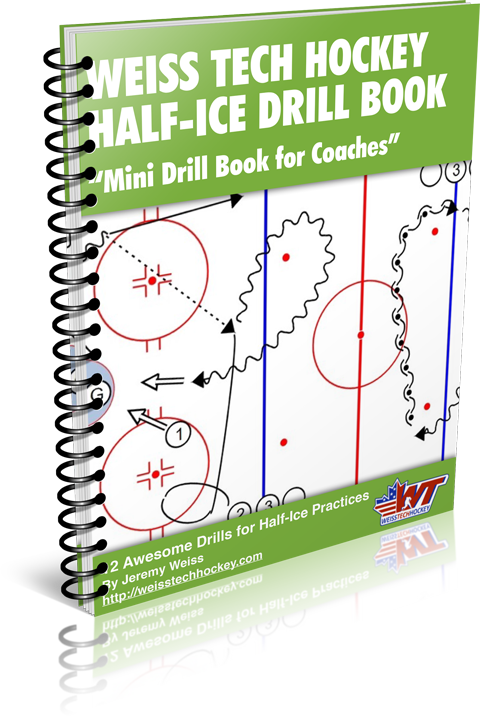What is Better for Mite Development, Cross-Ice or Full-Ice Gameplay?
There’s a hot debate going on in many parts of North America right now, and that is whether Mites are better off playing cross-ice or full-ice during games. This debate has grown largely out of USA Hockey’s ADM recommendation of cross-ice games until Squirt.
I grew up in the “full-ice world,” but I’ve been living in the “cross-ice world” for the past 3 years with my own kids. Folks in my local organization have asked my opinion on this a number of times, and I’ve also received a few emails asking my opinion. Here’s an example from one of our coaches in Chicago:
I’m writing to get your take on the cross-ice, USA Hockey model vs the full-ice model for mites. There was a big push in my aera for mites to play full ice and this year a northern chicago league was formed for those organizations. If you have already commented on this on your website, please advise. I just have a 3-year-old son, and I’m trying to educate my self as much as possible.
ARGUMENTS FOR CROSS-ICE PLAY
I haven’t said much, publicly, about cross-ice play. But I’ve been involved long enough now with my own kids that I’m ready to weigh in. So first, let’s take a look at USA Hockey’s arguments FOR cross-ice hockey at the 8U age groups:
- More efficient use of ice time and space
- Allows more kids to be on the ice at the same time
- Keeps costs down and aids in skill development
- Increases participation and skill development through more puck handling, more shots, more saves, more goals and more fun.
USA Hockey also put out this video to illustrate their point of view:
ARGUMENTS AGAINST CROSS-ICE PLAY
All of USA Hockey’s arguments sound legit, right? And once you see the video of the adults playing on that HUGE ice, that sort of cements the deal, ya? Well… in my mind it’s not that simple. Although the arguments for cross-ice play look good on paper, things begin to change after you’re into it for a few years.
Right away there are a few things that become apparent:
- Kids don’t learn the rules: offsides, stoppages of play, faceoff locations, icing, etc.
- No penalties: yes, coaches are supposed to “monitor and correct” illegal plays like checking and tripping, but it’s more clear in a child’s mind when the play is whistled dead, and the ref puts him or her in the penalty box. I’ve seen it first hand.
AND FINALLY… MY OPINION
Now, you might say, “Well ya… but the rules can be picked up later, and some organizations DO have refs. Neither of those points have much to do with development.”
I’d say that’s partially true, but here’s where folks who are truly DEVELOPMENTALLY ORIENTED should pay attention:
There are BIG variances in skill levels among players the 8U level. And by big, I mean HUGE.

Anyone who buys into the idea that one single program could be just as beneficial for the most beginner kid as it is for the most advanced kid has no business coaching––In my opinion.
If players are being properly developed, by the time they’re 7 and 8 years old the cross-ice sheet SHOULD be getting too small for them. At that point, I say open it up to full-ice games, or half-ice at the very least.
The cross-ice games is just one point of the ADM doctrine that is reflecting a bigger picture.
The problem is that USA Hockey (and most coaches in general) drastically underestimates what young players are capable of. They want to tell you it’s all about the kids having FUN. I agree with that, but WHAT IS FUN? Kids love improving, achieving, and overcoming. This happens through REAL competition, where rules are set and enforced, scores are kept, coaches invest in their OWN education, and skills are developed through structured sequences––not just through pond hockey repackaged as small area games.
Take a look at the video below. This is my son’s house team in a recent tournament, where they were permitted to play half-ice. You can see the approach we’ve taken has brought these kids to a level far beyond the other house teams.
“OK WEISS, MAKE YOUR POINT AND WRAP IT UP”
Admittedly, this topic has me on a bit of a soapbox. The reason for this is that I see it as a small piece of a much bigger developmental issue. That is the issue of “McDonald’s Style Coaching,” where coaches “don’t need to know anything… because the system will take care of the teaching.” (yes, as crazy as it sounds, this is actually being taught at USA Hockey coaching clinics).
As for the cross-ice games themselves, I like them for kids who can’t skate. But we need to adjust the game as skills progress, not just by blanket age groups. I prefer half-ice or full-ice for the kids who have developed beyond the competency of a beginner. I’d love to see a system where beginner Mites could play cross-ice, but where competitive teams (which are also being phased out at Mite) could play half or full ice.
As always… that’s my 2 cents worth. Take it or leave it!




